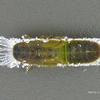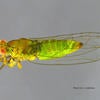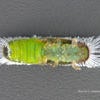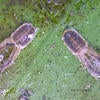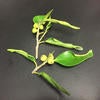Ficus leaf-rolling psyllid, Trioza brevigenae
Distribution: Ficus leaf-rolling psyllid was described by R. N. Mathur (1973) from specimens discovered in Dehra Dun, North India (collected on Ficus sp. leaves).
In the US T. brevigenae was first found in Los Angeles Co., California in April, 2016.
Field Identification: Adult (about 2.6-2.8 mm long) with light brownish-green head and thorax and green abdomen. Eyes are red. Wings are transparent, with no color pattern and are held tent-like above the body. Females are slightly larger than males.
Adults rest on the leaves with their abdomens raised at about 45-degree angle. They can be commonly observed wagging their abdomens from side to side in a constant movement.
Nymphs initially develop in oval, shallow pits on the leaf surfaces. Later they become mobile and brownish-green with elongate oval bodies. Advanced nymphal instars (reaching up to 2.5 mm) have distinctive long, white waxy filaments at the cranial and caudal parts of their bodies. Wing pads are typically visible in later developmental stages and are extended anteriorly close to eye level. Ficus leaf-rolling psyllids pass through five nymphal instars.
Hosts and damage: Attacks Ficus microcarpa trees. T. brevigenae causes leaves to tightly roll into narrow cylinders (about 3-5 mm in diameter). These cylinders may harbor various nymphal stages. Affected leaves become dry and brittle (at the same time remaining green). Extensive damage could reduce photosynthesis of Ficus trees and lead to defoliation on some branches.
Center for Invasive Species Research, University of California, Riverside
Text provided by: Gevork Arakelian. Publication Date 15 September, 2016
Photos provided by: Gevork Arakelian
Gevork Arakelian, Senior Biologist, Los Angeles County Agricultural Commissioner/Weights & Measures Department.
GArakelian@acwm.lacounty.gov
Media within CISR is licensed under a Creative Commons Attribution-NonCommercial-NoDerivs 3.0 Unported License. Permissions beyond this scope may be available at www.cisr.ucr.edu/media-usage.

